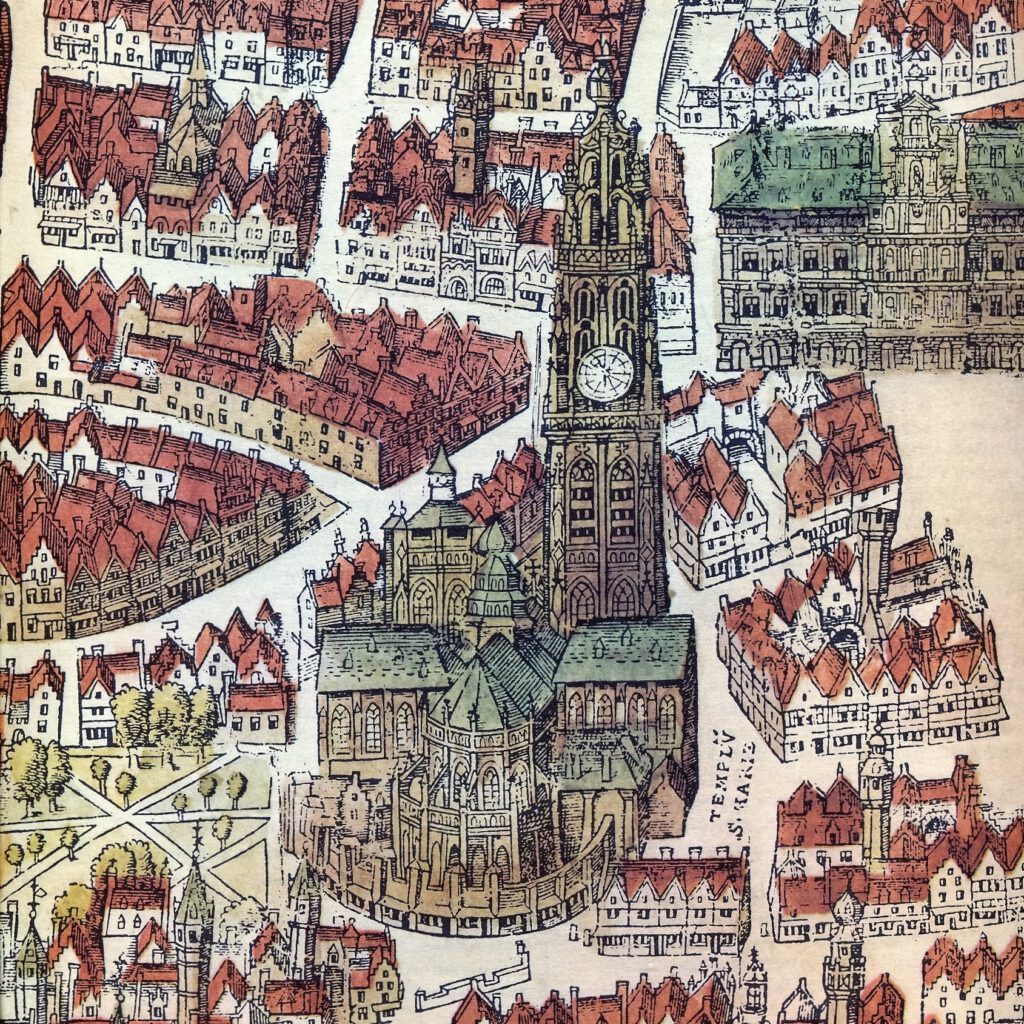The Our Lady’s Cathedral of Antwerp, a revelation.
Our Lady’s Assumption (Cornelis Schut)

Cornelis Schut could not think of a better location for the theme of Our Lady’s Assumption than the highest spot inside the cathedralThe main church of a diocese, where the bishop’s seat is.. The result is that his ceiling painting incites the spectator’s empathy even more than Rubens’s altarpiecePainted and/or carved back wall of an altar placed against a wall or pillar. Below the retable there is sometimes a predella. of the same subject. When looking up you witness willy-nilly ‘Mary’s Assumption’, at the risk of a sore neck. This round painting (1648) has a diameter of nearly 6 m (20 ft.) and has been positioned high up at 43.7 m (143 ft.). What is more, the trompe l’oeil pushes Mary’s elevation into infinite Heaven.

The lower sections with floating angels are the onset of an upward driving movement. They joyfully make music, as the original text in the crossingThe central point of a church with a cruciform floor plan. The crossing is the intersection between the longitudinal axis [the choir and the nave] and the transverse axis [the transept]. lantern used to say in large letters: ASSUMPTA EST MARIA IN CAELI, GAUDENT ANGELI (Mary was taken up in Heaven. Angels, rejoice). This sentence was taken from the offertory of the feast of Our Lady’s Assumption. In the centre there is Our Lady, clearly in blue, straight in the heart of this seething crowd of angels. In her dress the stopper for the opening through which it has to be possible to hoist the painting up with ropes has been incorporated nearly invisibly. Finally Mary can expect a warm welcome in Heaven by her son, God the FatherPriest who is a member of a religious order. and – barely visible – the Holy SpiritThe active power of God in people. It inspires people to make God present in the world. Jesus was ‘filled with the Holy Spirit’ and thus showed in his speech and actions what God is like. People who allow the Holy Spirit to work in them also speak and act like God and Jesus at those moments. See also ‘Pentecost’., in the shape of a dove, in between them. Mary, who has already found her final destination with God in Heaven, receives special attention here because this feast of Our Lady’s Assumption is the feast of the patron of the main church, the town and the diocese. To everybody who visits this place, she points out the final destination of life on Earth: ascending to eternal happiness with God in Heaven.
We need not be surprised that of all the paintings this one was not purloined by the French conquerors, taking into account the logistic challenge it involved. The high crossing cupola was once the scene of superior liturgical spectacles with matching sounds. Thus at Whitsun in the Baroque period first thunder was imitated and then a stretched tissue was rolled open from which, as in a genuine effect of surprise, a huge cascade of red paper frames tumbled down as if the ‘tongues of fire’, which once inspired the disciples, also descended onto the worshipers in the church. For the glorious feast of the crowning of Our Lady’s statue on 15 August 1899, with music by Kapellmeister Emile Wambach, a better location could not be found: While blasts of trumpets resounded from the high cupola and a choirIn a church with a cruciform floor plan, the part of the church that lies on the side of the nave opposite to the transept. The main altar is in the choir. of angelical sweet children’s voices wove Regina Caeli so divinely through the aisles, cardinalIn the Roman Catholic Church, a cardinal is a member of the pope’s council and thus he has an important advisory role. Up to the age of eighty, the cardinals also elect the new pope. Most cardinals are also bishops, but this is not a requirement. Goossens in a solemn gesture put the consecratedIn the Roman Catholic Church, the moment when, during the Eucharist, the bread and wine are transformed into the body and blood of Jesus, the so-called transubstantiation, by the pronouncement of the sacramental words. crown with its trickling pearls onto the head of the Mother of God. It was grandiose, like a heavenly event, and a devoted glow of excitement spread below the old vaultings when the majestic orchestra struck up and Our Lady’s statue solemnly rose up a few feet from its plinth.
- Our Lady’s Cathedral
- History & Description
- Preface
- Introduction
- Historical context
- A centuries-long building history
- A cathedral never stands alone
- Our Lady’s spire
- The main portal
- Spatial effect
- Mary’s Assumption (C.Schut)
- Erection of the Cross (PP.Rubens)
- Descent of the Cross (PP.Rubens)
- The Resurrection (PP.Rubens)
- Mary’s Assumption (PP.Rubens)
- The high altar
- The collegial choir
- The bishop’s church
- The parish church
- The pulpit
- The confessionals
- Caring for the poor
- The Venerable chapel
- Mary’s chapel
- Corporations and guilds
- The ambulatory
- Funeral monuments
- Praise the Lord!
- Pull all stops: the organs
- Cross-bearer (J.Fabre)
- Bibliography


